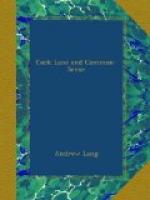Now, by a great piece of good fortune, Mr. Greatrakes the fragrant and miraculous, had also been an eye-witness of this miracle, and was able to give Lady Conway and her guests the fullest information. As commonly happened in the seventeenth century, though not in ours, the marvel of the butler was mixed up with ordinary folklore. In the records and researches of the existing Society for Psychical Research, folklore and fairies hold no place. The Conformist, however, had this tale to tell: the butler of a gentleman unnamed, who lived near Lord Orrery’s seat in Ireland, fell in, one day, with the good people, or fairies, sitting at a feast. The fairies, therefore, endeavoured to spirit him away, as later they carried off Mr. Kirk, minister of Aberfoyle, in 1692. Lord Orrery, most kindly, gave the butler the security of his castle, where the poor man was kept, ‘under police protection,’ and watched, in a large room. Among the spectators were Mr, Greatrakes himself, and two bishops, one of whom may have been Jeremy Taylor, an active member of the society. Late in the afternoon, the butler was ’perceived to rise from the ground, whereupon Mr. Greatrix and another lusty man clapt their hands over his shoulders, one of them before, and the other behind, and weighed him down with all their strength, but he was forcibly taken up from them; for a considerable time he was carried in the air to and fro, over their heads, several of the company still running under him, to prevent him receiving hurt if he should fall;’ so says Glanvill. Faithorne illustrates this pleasing circumstance by a picture of the company standing out, ready to ‘field the butler, whose features display great concern.’ {90a}
Now we know that Mr. Greatrakes told this anecdote, at Ragley, first to Mrs. Foxcroft, and then to the company at dinner. Mr. Alfred Wallace, F.R.S., adduces Lord Orrery and Mr. Greatrakes as witnesses of this event in private life. Mr. Wallace, however, forgets to tell the world that the fairies, or good people, were, or were believed to be, the agents. {90b} Fairies still cause levitation in the Highlands. Campbell of Islay knew a doctor, one of whose patients had in vain tried to hold down a friend who was seized and carried to a distance of two miles by the sluagh, the fairy folk. {90c} Glanvill admits that Lord Orrery assured Lady Roydon, one of the party at Ragley, that the Irish tale was true: Henry More had it direct from Mr. Greatrakes.
Here is a palpably absurd legend, but the reader is requested to observe that the phenomenon is said to have occurred in all ages and countries. We can adduce the testimony of modern Australian blacks, of Greek philosophers, of Peruvians just after the conquest by Pizarro, of the authors of Lives of the Saints, of learned New England divines, of living observers in England, India, and America. The phenomenon is technically styled ‘levitation,’ and in England was regarded as a proof either of witchcraft




